Universal Learning Approach of an Intelligent Algorithm for Non-GNSS Assisted Beamsteering in V2I Systems
Abstract
1. Introduction
2. Beamsteering System Concept and PAA’s Simulation Model
2.1. Beamsteering System Hardware
2.2. PAA Simulation Model
- Length of the antenna array is 0.388 m;
- The antenna array pitch is mm;
- Number of emitters is 14;
- Scanning sector of the PAA in the horizontal plane is 45°;
- The main lobe width at half maximum in the horizontal plane is 9°.
3. The Learning Approach of the Intelligent Algorithm
3.1. Dataset Generation and Simulation of the Signal Propagation Environment
3.2. Traffic Model
3.3. ML Algorithm
- Learning rate is 0.1.
- Number of iterations is 100.
- Booster (booster algorithm) is GBTree.
- Maximum depth of a tree is 11.
- Eval metric is Multiclass logloss.
4. Simulation and Results
- Terrain resolution is 4000 × 4000 dots.
- Serving area radius is 600 m.
- Infrastructure object coordinates are 34.765406 N, 113.650334 E.
- The height of the antenna suspension of the infrastructure object is 5 m.
- The simulation steps number for all vehicles was 100.
- The average vehicles speed on the highway was 15.11 m/s.
- The cars and trucks ratio was 50/50%.
4.1. Learning ML Algorithm
4.2. Testing ML Algorithm
5. Conclusions
Author Contributions
Funding
Institutional Review Board Statement
Informed Consent Statement
Data Availability Statement
Conflicts of Interest
Sample Availability
References
- Habibovic, A.; Davidsson, J. Causation mechanisms in car-to-vulnerable road user crashes: Implications for active safety systems. Accid. Anal. Prev. 2012, 49, 493–500. [Google Scholar] [CrossRef]
- Figueiredo, L.; Jesus, I.; Tenreiro Machado, J.A.; Rui Ferreira, J.; Martins De Carvalho, J.L. Towards the development of intelligent transportation systems. In Proceedings of the ITSC 2001. 2001 IEEE Intelligent Transportation Systems. Proceedings (Cat. No. 01TH8585), Oakland, CA, USA, 25–29 August 2001; pp. 1206–1211. [Google Scholar] [CrossRef]
- Liebemann, E.; Meder, K.; Schuh, J.; Nenninger, G. Safety and performance enhancement: The Bosch electronic stability control (ESP). SAE Pap. 2004, 20004, 21-0060. [Google Scholar]
- Høye, A. The effects of Electronic Stability Control (ESC) on crashes—An update. Accid. Anal. Prev. 2011, 43, 1148–1159. [Google Scholar] [CrossRef]
- Öörni, R.; Luoma, J. Realised safety impacts of electronic stability control in Finland. IET Intell. Transp. Syst. 2017, 11, 158–163. [Google Scholar] [CrossRef]
- Hasan, K.F.; Wang, C.; Feng, Y.; Tian, Y.C. Time synchronization in vehicular ad-hoc networks: A survey on theory and practice. Veh. Commun. 2018, 14, 39–51. [Google Scholar] [CrossRef]
- Vukadinovic, V.; Bakowski, K.; Marsch, P.; Garcia, I.D.; Xu, H.; Sybis, M.; Sroka, P.; Wesolowski, K.; Lister, D.; Thibault, I. 3GPP C-V2X and IEEE 802.11p for Vehicle-to-Vehicle communications in highway platooning scenarios. Ad Hoc Netw. 2018, 74, 17–29. [Google Scholar] [CrossRef]
- Agiwal, M.; Roy, A.; Saxena, N. Next generation 5G wireless networks: A comprehensive survey. IEEE Commun. Surv. Tutor. 2016, 18, 1617–1655. [Google Scholar] [CrossRef]
- Choi, J.; Va, V.; González-Prelcic, N.; Daniels, R.; Bhat, C.R.; Heath, R.W. Millimeter Wave Vehicular Communication to Support Massive Automotive Sensing. IEEE Commun. Mag. 2016, 54, 160–167. [Google Scholar] [CrossRef]
- Reus-Muns, G.; Salehi, B.; Roy, D.; Jian, T.; Wang, Z.; Dy, J.; Ioannidis, S.; Chowdhury, K. Deep Learning on Visual and Location Data for V2I mmWave Beamforming. In Proceedings of the 2021 17th International Conference on Mobility, Sensing and Networking (MSN), Exeter, UK, 13–15 December 2021; pp. 559–566. [Google Scholar] [CrossRef]
- Milanés, V.; Villagrá, J.; Godoy, J.; Simó, J.; Pérez, J.; Onieva, E. An Intelligent V2I—Based Traffic Management System. IEEE Trans. Intell. Transp. Syst. 2012, 13, 49–58. [Google Scholar] [CrossRef]
- Pallotta, A.; Roux, P.; Del Rio, D.; Sevillano, J.F.; Pirbazari, M.M.; Mazzanti, A.; Ermolov, V.; Lamminen, A.; Säily, J.; Frecassetti, M.; et al. SiGe:BiCMOS technology is enabling d-band link with active phased antenna array. In Proceedings of the Joint European Conference on Networks and Communications and 6G Summit, EuCNC/6G Summit 2021, Porto, Portugal, 8–11 June 2021; pp. 496–501. [Google Scholar] [CrossRef]
- Gu, X.; Liu, D.; Baks, C.; Tageman, O.; Sadhu, B.; Hallin, J.; Rexberg, L.; Parida, P.; Kwark, Y.; Valdes-Garcia, A. Development, Implementation, and Characterization of a 64-Element Dual-Polarized Phased-Array Antenna Module for 28-GHz High-Speed Data Communications. IEEE Trans. Microw. Theory Tech. 2019, 67, 2975–2984. [Google Scholar] [CrossRef]
- Halbauer, H.; Saur, S.; Koppenborg, J.; Hoek, C. 3D beamforming: Performance improvement for cellular networks. Bell Labs Tech. J. 2013, 18, 37–56. [Google Scholar] [CrossRef]
- Bazzi, A.; Masini, B.M.; Zanella, A.; Thibault, I. On the Performance of IEEE 802.11p and LTE-V2V for the Cooperative Awareness of Connected Vehicles. IEEE Trans. Veh. Technol. 2017, 66, 10419–10432. [Google Scholar] [CrossRef]
- IEEE Standard for Information Technology–Telecommunications and Information Exchange between Systems–Local and Metropolitan Area Networks–Specific Requirements-Part 11: Wireless LAN Medium Access Control (MAC) and Physical Layer (PHY) Specifications Amendment 3: Enhancements for Very High Throughput in the 60 GHz Band. IEEE Std 802.11ad-2012 (Amendment to IEEE Std 802.11-2012, as Amended by IEEE Std 802.11ae-2012 and IEEE Std 802.11aa-2012). 2012, pp. 1–628. Available online: https://ieeexplore.ieee.org/document/6392842 (accessed on 21 December 2022). [CrossRef]
- Mattos, M.; Rodrigues, A.; Meireles, R.; Aguiar, A. Geolocation-based sector selection for Vehicle-to-Infrastructure 802.11ad communication. Comput. Commun. 2022, 193, 224–233. [Google Scholar] [CrossRef]
- Va, V.; Shimizu, T.; Bansal, G.; Heath, R.W. Beam design for beam switching based millimeter wave vehicle-to-infrastructure communications. In Proceedings of the 2016 IEEE International Conference on Communications, ICC 2016, Kuala Lumpur, Malaysia, 22–27 May 2016. [Google Scholar] [CrossRef]
- Meguro, J.I.; Murata, T.; Takiguchi, J.I.; Amano, Y.; Hashizume, T. GPS multipath mitigation for urban area using omnidirectional infrared camera. IEEE Trans. Intell. Transp. Syst. 2009, 10, 22–30. [Google Scholar] [CrossRef]
- Cui, Y.J.; Ge, S.S. Autonomous vehicle positioning with GPS in urban canyon environments. Proc.-IEEE Int. Conf. Robot. Autom. 2001, 2, 1105–1110. [Google Scholar] [CrossRef]
- Kenney, J.B. Dedicated short-range communications (DSRC) standards in the United States. Proc. IEEE 2011, 99, 1162–1182. [Google Scholar] [CrossRef]
- Agarwal, Y.; Jain, K.; Karabasoglu, O. Smart vehicle monitoring and assistance using cloud computing in vehicular Ad Hoc networks. Int. J. Transp. Sci. Technol. 2018, 7, 60–73. [Google Scholar] [CrossRef]
- Klautau, A.; Batista, P.; Gonzalez-Prelcic, N.; Wang, Y.; Heath, R.W. 5G MIMO data for machine learning: Application to beam-selection using deep learning. In Proceedings of the 2018 Information Theory and Applications Workshop (ITA 2018), San Diego, CA, USA, 11–16 February 2018. [Google Scholar] [CrossRef]
- Hu, Q.; Liu, Y.; Cai, Y.; Yu, G.; DIng, Z. Joint Deep Reinforcement Learning and Unfolding: Beam Selection and Precoding for mmWave Multiuser MIMO with Lens Arrays. IEEE J. Sel. Areas Commun. 2021, 39, 2289–2304. [Google Scholar] [CrossRef]
- Ma, W.; Qi, C.; Li, G.Y. Machine Learning for Beam Alignment in Millimeter Wave Massive MIMO. IEEE Wirel. Commun. Lett. 2020, 9, 875–878. [Google Scholar] [CrossRef]
- Nitsche, T.; Flores, A.B.; Knightly, E.W.; Widmer, J. Steering with eyes closed: Mm-Wave beam steering without in-band measurement. Proc.-IEEE INFOCOM 2015, 26, 2416–2424. [Google Scholar] [CrossRef]
- Va, V.; Choi, J.; Shimizu, T.; Bansal, G.; Heath, R.W. Inverse multipath fingerprinting for millimeter wave V2I beam alignment. IEEE Trans. Veh. Technol. 2018, 67, 4042–4058. [Google Scholar] [CrossRef]
- 5GAA. 5GAA P-190033: V2X Functional and Performance Test Report; Test Procedures and Results; 5GAA: Munich, Germany, 2019. [Google Scholar]
- Misra, R.; Grover, J. Sculpting Data for ML: The First Act of Machine Learning; University of California San Diego: La Jolla, CA, USA, 2021; p. 158. [Google Scholar]
- Varga, N.; Bokor, L.; Takacs, A.; Kovacs, J.; Virag, L. An architecture proposal for V2X communication-centric traffic light controller systems. In Proceedings of the 2017 15th International Conference on ITS Telecommunications (ITST 2017), Warsaw, Poland, 29–31 May 2017. [Google Scholar] [CrossRef]
- Radak, J.; Ducourthial, B.; Cherfaoui, V.; Bonnet, S. Detecting road events using distributed data fusion: Experimental evaluation for the icy roads case. IEEE Trans. Intell. Transp. Syst. 2016, 17, 184–194. [Google Scholar] [CrossRef]
- Ruta, M.; Scioscia, F.; Pinto, A.; Gramegna, F.; Ieva, S.; Loseto, G.; Sciascio, E.D. A CoAP-based framework for collaborative sensing in the Semantic Web of Things. Procedia Comput. Sci. 2017, 109, 1047–1052. [Google Scholar] [CrossRef]
- Scholliers, J.; Jutila, M.; Valta, M.; Kauvo, K.; Virtanen, A.; Pyykönen, P. Co-operative Traffic Solutions for Hybrid Communication Environments. Transp. Res. Procedia 2016, 14, 4542–4551. [Google Scholar] [CrossRef]
- Shagdar, O.; Muhlethaler, P. Study on merging control supported by IEEE 802.11p systems for highway environments. In Proceedings of the 2013 IFIP Wireless Days (WD), Valencia, Spain, 13–15 November 2013. [Google Scholar] [CrossRef]
- Ghandour, A.J.; Fawaz, K.; Artail, H.; Di Felice, M.; Bononi, L. Improving vehicular safety message delivery through the implementation of a cognitive vehicular network. Ad Hoc Netw. 2013, 11, 2408–2422. [Google Scholar] [CrossRef]
- Khabbaz, M.; Assi, C.; Hasna, M.; Ghrayeb, A.; Fawaz, W. Modelling, analysis and performance improvement of an SRU’s access request queue in multi-channel V2I communications. Pervasive Mob. Comput. 2015, 21, 92–102. [Google Scholar] [CrossRef]
- Sadou, M.; Bouallouche-Medjkoune, L. Efficient message delivery in hybrid sensor and vehicular networks based on mathematical linear programming. Comput. Electr. Eng. 2017, 64, 496–505. [Google Scholar] [CrossRef]
- Shao, C.; Leng, S.; Zhang, Y.; Fu, H. A multi-priority supported medium access control in Vehicular Ad Hoc Networks. Comput. Commun. 2014, 39, 11–21. [Google Scholar] [CrossRef]
- Durech, J.; Hrubos, M.; Franekova, M.; Janota, A. Implementation of data from the mobile measurement platform to VANET application. In Proceedings of the 10th International Conference (ELEKTRO 2014), Rajecke Teplice, Slovakia, 19–20 May 2014; pp. 430–434. [Google Scholar] [CrossRef]
- Zagrouba, R.; Hayouni, H.; Kamoun, F. Handover optimization within vehicular networks. In Proceedings of the 2014 World Congress on Computer Applications and Information Systems (WCCAIS 2014), Hammamet, Tunisia, 17–19 January 2014. [Google Scholar] [CrossRef]
- Johansson, I.; Jin, J.; Ma, X.; Pettersson, H. Look-ahead speed planning for heavy-duty vehicle platoons using traffic information. Transp. Res. Procedia 2017, 22, 561–569. [Google Scholar] [CrossRef]
- He, Z.; Zhang, D. Cost-efficient traffic-aware data collection protocol in VANET. Ad Hoc Netw. 2017, 55, 28–39. [Google Scholar] [CrossRef]
- Ronza, A.; Félez, S.; Darbra, R.M.; Carol, S.; Vílchez, J.A.; Casal, J. Predicting the frequency of accidents in port areas by developing event trees from historical analysis. J. Loss Prev. Process. Ind. 2003, 16, 551–560. [Google Scholar] [CrossRef]
- Lopukhova, E.A.; Grakhova, E.P.; Voronkov, G.S.; Kutluyarov, R.V. Gradient Boosting Algorithms Application for Beamsteering in V2X Systems. In Proceedings of the 2022 IEEE 23rd International Conference of Young Professionals in Electron Devices and Materials (EDM), Altai, Russia, 30 June–4 July 2022; pp. 195–199. [Google Scholar] [CrossRef]
- Ishmiyarov, A.A.; Kutluyarov, R.V.; Grakhova, E.P.; Voronkov, G.S. Microstrip Emitter Design for Application in V2X Beamsteering Systems. In Proceedings of the 2022 IEEE 23rd International Conference of Young Professionals in Electron Devices and Materials (EDM), Altai, Russia, 30 June–4 July 2022; pp. 279–284. [Google Scholar] [CrossRef]
- Abdi Kordani, A.; Rahmani, O.; Abdollahzadeh Nasiri, A.S.; Boroomandrad, S.M. Effect of Adverse Weather Conditions on Vehicle Braking Distance of Highways. Civ. Eng. J. 2018, 4, 46. [Google Scholar] [CrossRef]
- Lopez, P.A.; Behrisch, M.; Bieker-Walz, L.; Erdmann, J.; Flotterod, Y.P.; Hilbrich, R.; Lucken, L.; Rummel, J.; Wagner, P.; Wiebner, E. Microscopic Traffic Simulation using SUMO. In Proceedings of the IEEE Conference on Intelligent Transportation Systems, Proceedings, ITSC, Maui, HI, USA, 4–7 November 2018; pp. 2575–2582. [Google Scholar] [CrossRef]
- Oughton, E.; Russell, T.; Johnson, J.; Yardim, C.; Kusuma, J. itmlogic: The Irregular Terrain Model by Longley and Rice. J. Open Source Softw. 2020, 5, 2266. [Google Scholar] [CrossRef]
- P.2001: A General Purpose Wide-Range Terrestrial Propagation Model in the Frequency Range 30 MHz to 50 GHz. 2021. Available online: https://www.itu.int/rec/R-REC-P.2001/en (accessed on 21 December 2022).
- P.1411-11. Propagation Data and Prediction Methods for the Planning of Short-Range Outdoor Radiocommunication Systems and Radio Local Area Networks in the Frequency Range 300 MHz to 100 GHz. 2021. Available online: https://www.itu.int/rec/R-REC-P.1411/en (accessed on 21 December 2022).
- Treiber, M.; Kesting, A. The Lighthill–Whitham–Richards Model. In Traffic Flow Dynamics; Springer: Berlin, Germany, 2013; pp. 81–126. [Google Scholar] [CrossRef]
- Gartner, N.H.; Messer, C.J.; Rathi, A.K. (Eds.) Traffic Flow Theory: A State-of-the-Art Report; Transportation Research Board: Washington, DC, USA, 2001. [Google Scholar]
- Fricke, L.B. Traffic Accident Reconstruction (The Traffic Accident Investigation Manual, Vol. 2) 1990 First Edition; Northwestern University Center for Public: Evanston, IL, USA, 1990. [Google Scholar]
- Parvez, I.; Rahmati, A.; Guvenc, I.; Sarwat, A.I.; Dai, H. A survey on low latency towards 5G: RAN, core network and caching solutions. IEEE Commun. Surv. Tutor. 2018, 20, 3098–3130. [Google Scholar] [CrossRef]
- Friedman, J.H. Stochastic gradient boosting. Comput. Stat. Data Anal. 2002, 38, 367–378. [Google Scholar] [CrossRef]
- Chen, T.; Guestrin, C. XGBoost: A Scalable Tree Boosting System. In Proceedings of the 22nd ACM SIGKDD International Conference on Knowledge Discovery and Data Mining, New York, NY, USA, 13–17 August 2016; pp. 785–794. [Google Scholar] [CrossRef]
- Tahir, M.N.; Leviäkangas, P.; Katz, M. Connected Vehicles: V2V and V2I Road Weather and Traffic Communication Using Cellular Technologies. Sensors 2022, 22, 1142. [Google Scholar] [CrossRef] [PubMed]
- Ojanperä, T.; Kutila, M.; Pyykönen, P.; Scholliers, J.; Sukuvaara, T.; Mäenpää, K.; Huuskonen, O. Development and Piloting of Novel 5G-Enabled Road Safety Services. In Proceedings of the IEEE Wireless Communications and Networking Conference Workshop (WCNCW), Marrakech, Morocco, 15–18 April 2019; pp. 1–6. [Google Scholar] [CrossRef]
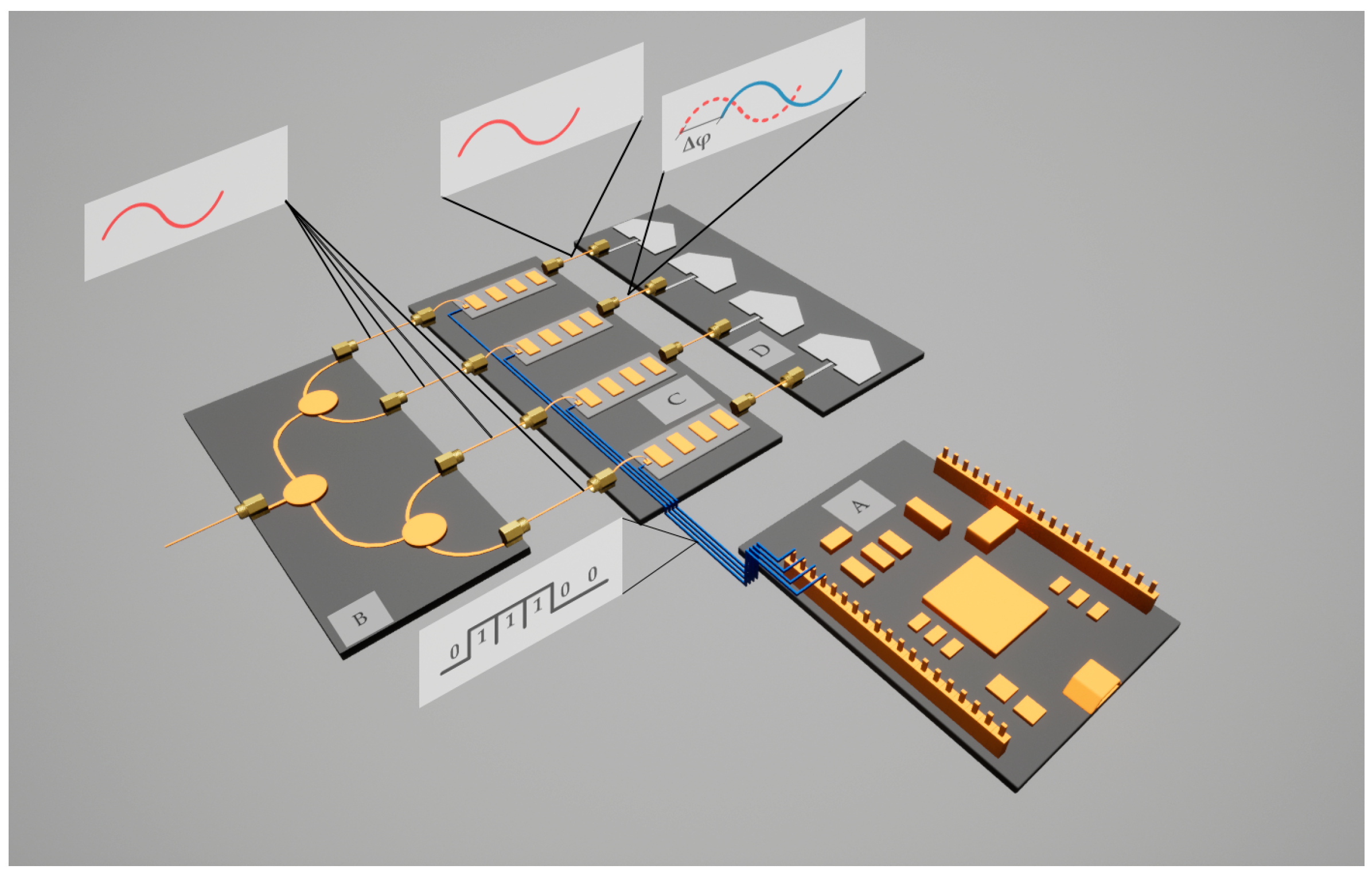
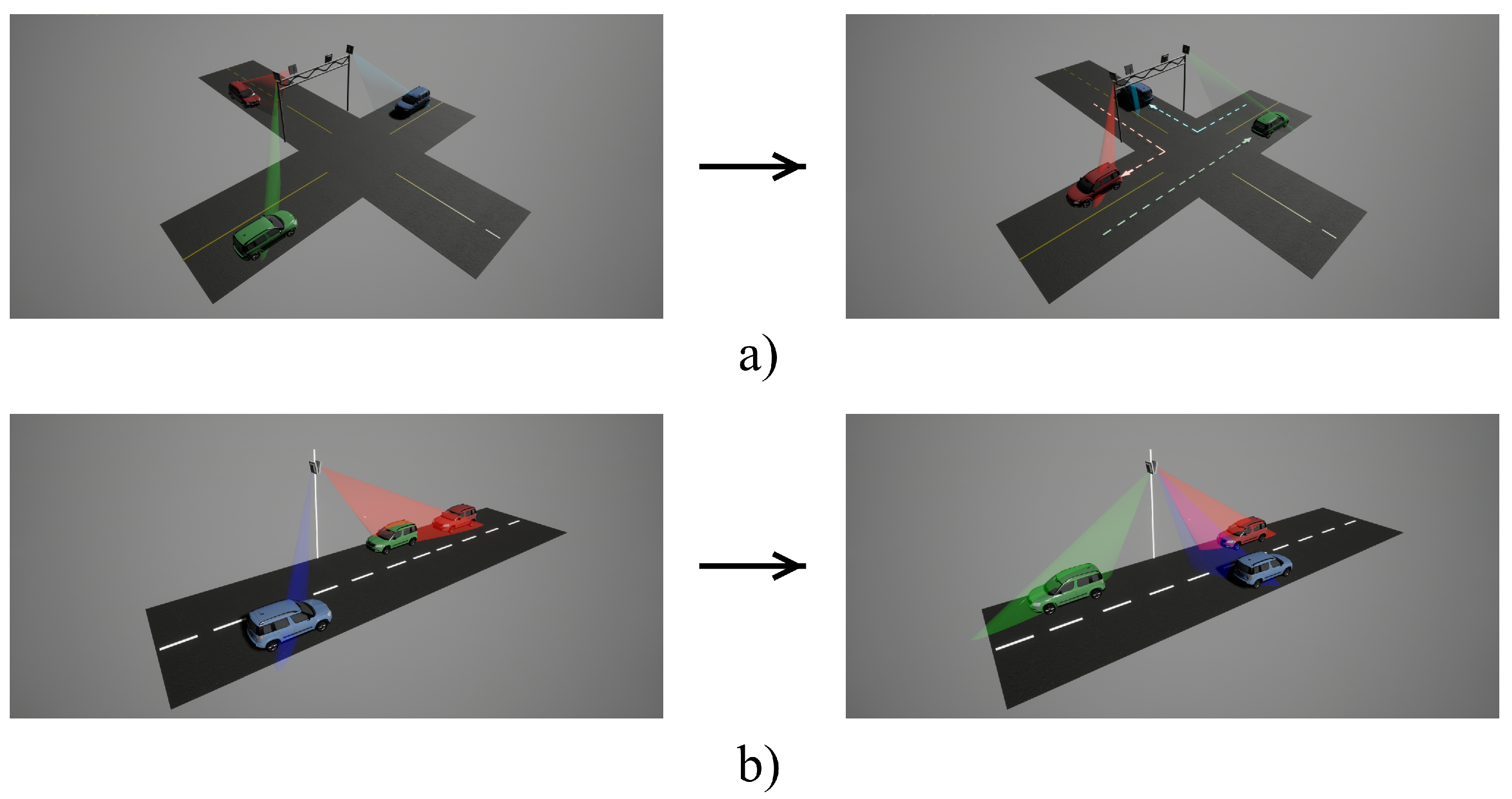
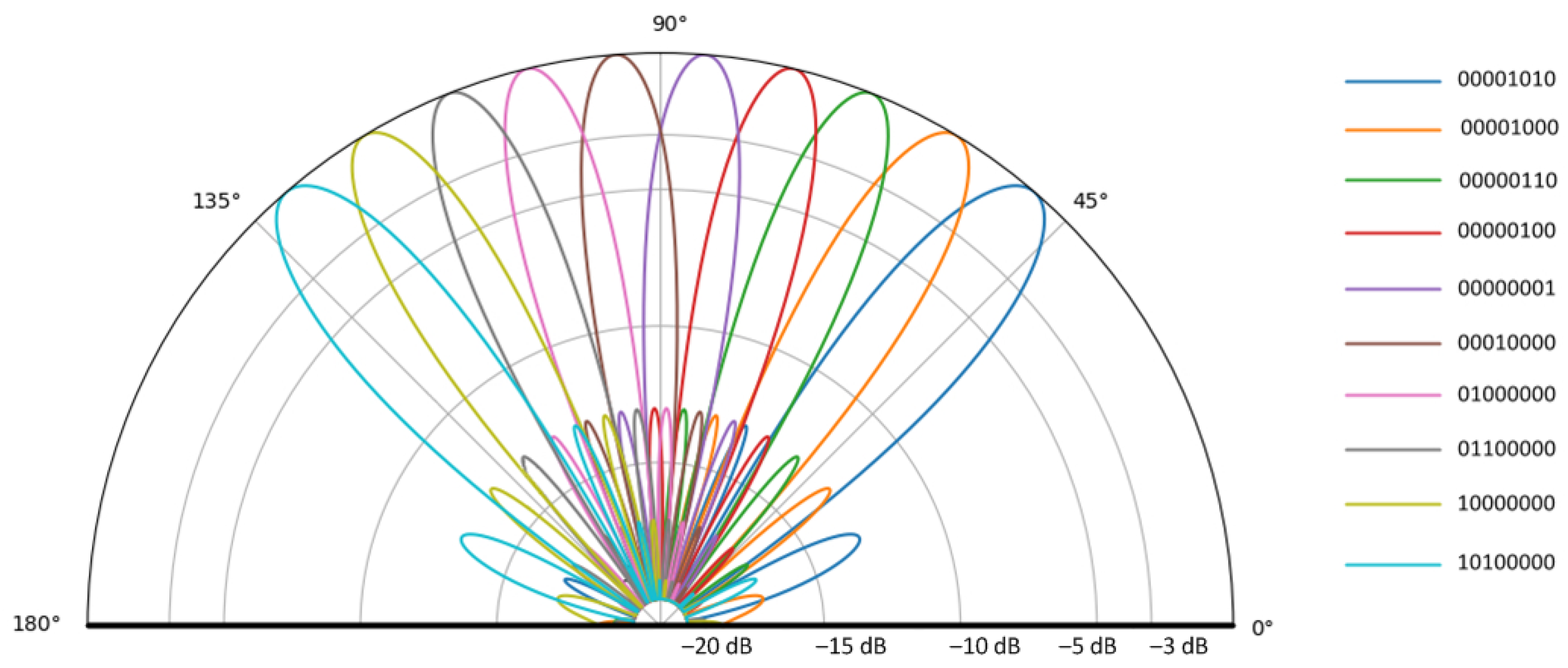
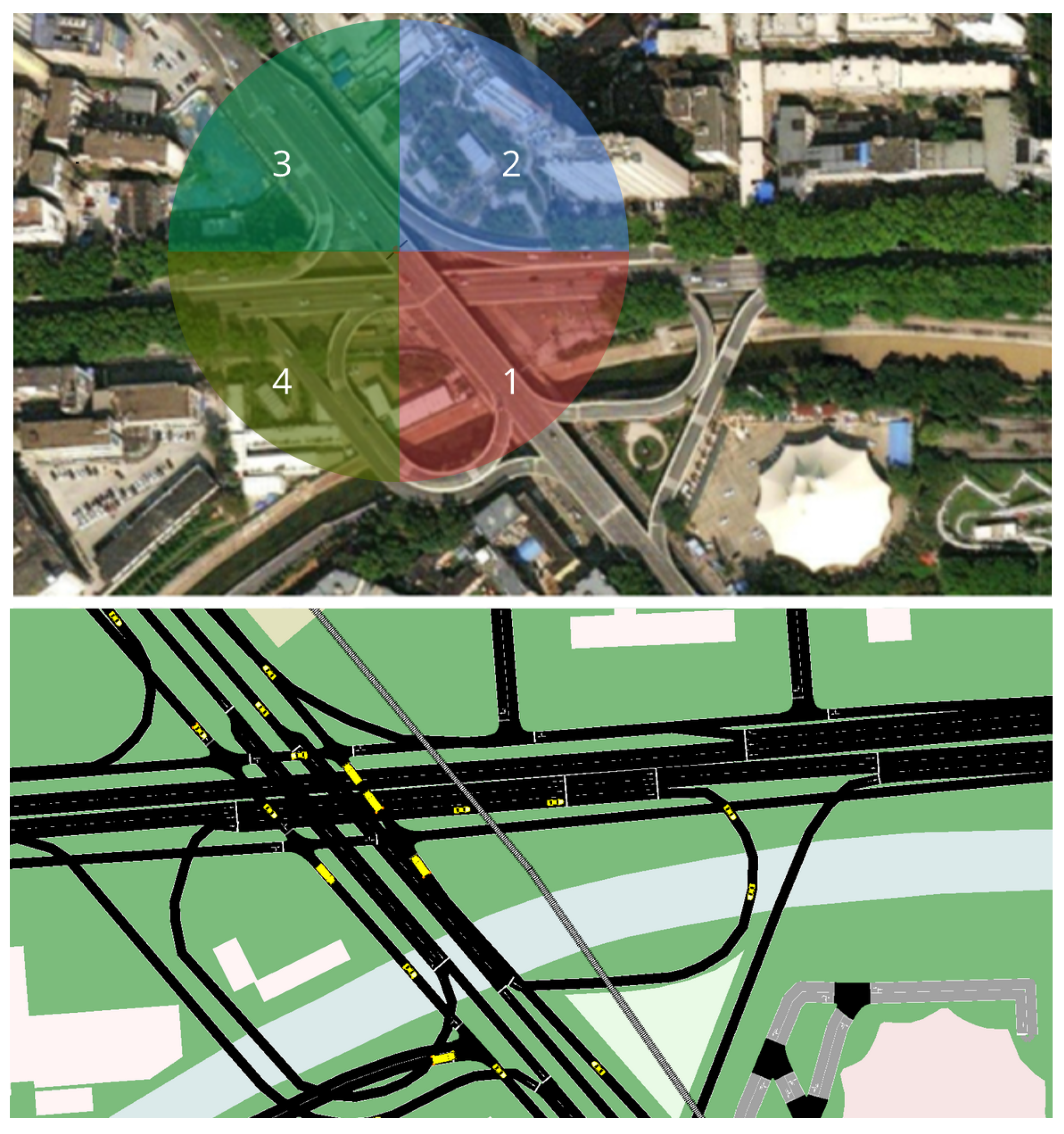
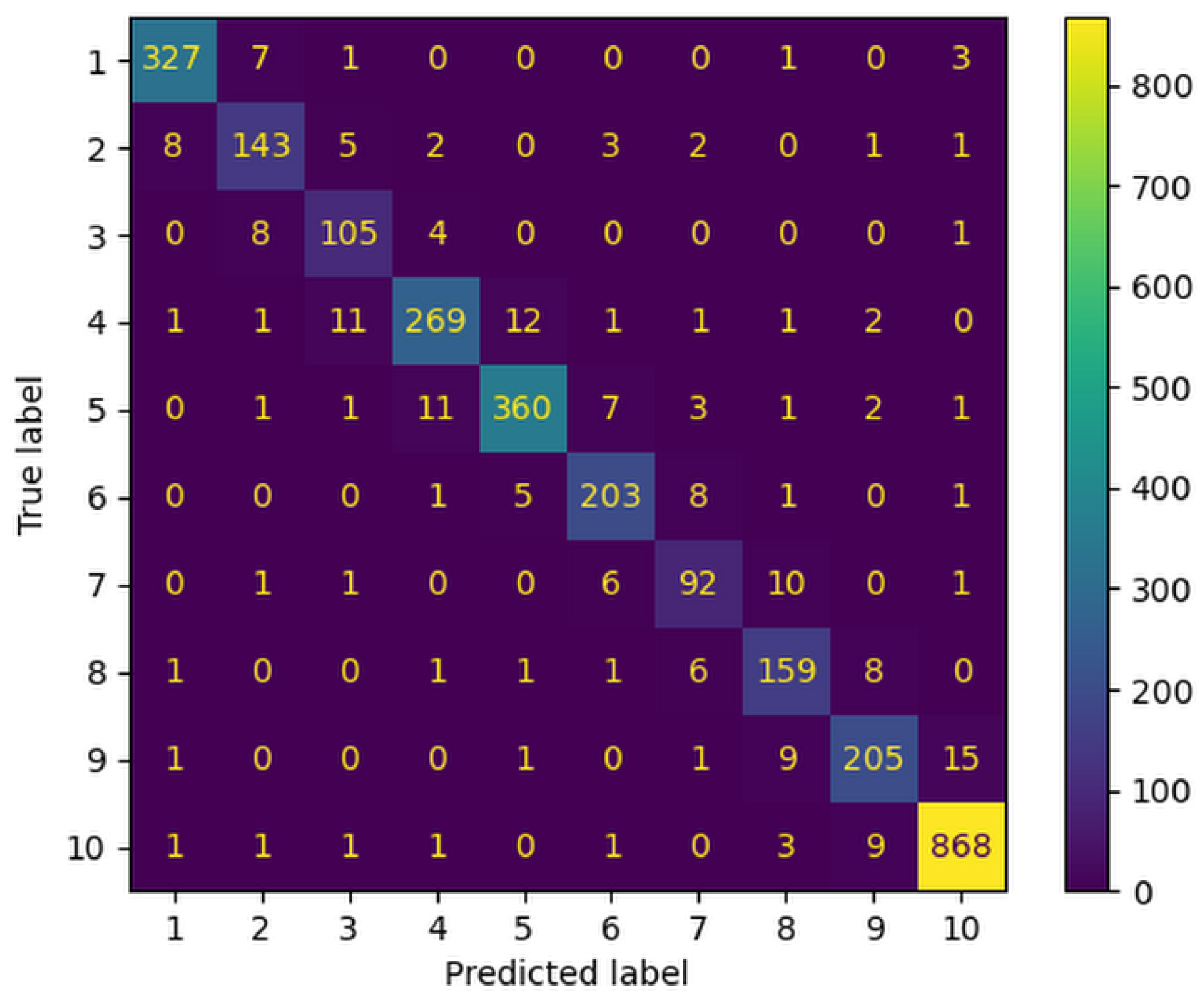
| Sub-Sector Number | , deg | , deg | Control Code |
|---|---|---|---|
| 1 | −40.5 | −116.9 | 10100000 |
| 2 | −31.5 | −94.05 | 10000000 |
| 3 | −22.5 | −68.88 | 01100000 |
| 4 | −13.5 | −42.02 | 01000000 |
| 5 | −4.5 | −14.12 | 00010000 |
| 6 | 4.5 | 14.12 | 00000001 |
| 7 | 13.5 | 42.02 | 00000100 |
| 8 | 22.5 | 68.88 | 00000110 |
| 9 | 31.5 | 94.05 | 00001000 |
| 10 | 40.5 | 116.9 | 00001010 |
| Time Delays, s | Type of Vehicle | Received Signal Level, dB | Vehicle Speed, m/s | Rotation Angle, deg | Antenna | Sector Number |
|---|---|---|---|---|---|---|
| 1.8 | car | −75.1 | 14.72 | 85.74 | 1 | 2 |
| 1.97 | truck | −83.1 | 10.8 | 0 | 2 | 4 |
| Traffic Intensity, Car Per Hour | Vehicles with Atypical Behavior, % | Average Deviation of Received Signal Level, dB | Probability of Power Reduction by More than 3 dB |
|---|---|---|---|
| 1222.95 | 0 | −2.43 | 0.06 |
| 1227.17 | 10 | −2,67 | 0.07 |
| 1219.37 | 20 | −2.85 | 0.08 |
| 1218.34 | 30 | –2.76 | 0.084 |
| 1220.13 | 40 | −3.01 | 0.095 |
| 2552.52 | 0 | −2.14 | 0.04 |
| 2769.1 | 10 | −2.81 | 0.07 |
| 2840.12 | 20 | −3.11 | 0.071 |
| 3256.17 | 0 | −2.05 | 0.05 |
| 3535.34 | 10 | −3.21 | 0.1 |
Disclaimer/Publisher’s Note: The statements, opinions and data contained in all publications are solely those of the individual author(s) and contributor(s) and not of MDPI and/or the editor(s). MDPI and/or the editor(s) disclaim responsibility for any injury to people or property resulting from any ideas, methods, instructions or products referred to in the content. |
© 2023 by the authors. Licensee MDPI, Basel, Switzerland. This article is an open access article distributed under the terms and conditions of the Creative Commons Attribution (CC BY) license (https://creativecommons.org/licenses/by/4.0/).
Share and Cite
Lopukhova, E.; Abdulnagimov, A.; Voronkov, G.; Kutluyarov, R.; Grakhova, E. Universal Learning Approach of an Intelligent Algorithm for Non-GNSS Assisted Beamsteering in V2I Systems. Information 2023, 14, 86. https://doi.org/10.3390/info14020086
Lopukhova E, Abdulnagimov A, Voronkov G, Kutluyarov R, Grakhova E. Universal Learning Approach of an Intelligent Algorithm for Non-GNSS Assisted Beamsteering in V2I Systems. Information. 2023; 14(2):86. https://doi.org/10.3390/info14020086
Chicago/Turabian StyleLopukhova, Ekaterina, Ansaf Abdulnagimov, Grigory Voronkov, Ruslan Kutluyarov, and Elizaveta Grakhova. 2023. "Universal Learning Approach of an Intelligent Algorithm for Non-GNSS Assisted Beamsteering in V2I Systems" Information 14, no. 2: 86. https://doi.org/10.3390/info14020086
APA StyleLopukhova, E., Abdulnagimov, A., Voronkov, G., Kutluyarov, R., & Grakhova, E. (2023). Universal Learning Approach of an Intelligent Algorithm for Non-GNSS Assisted Beamsteering in V2I Systems. Information, 14(2), 86. https://doi.org/10.3390/info14020086








